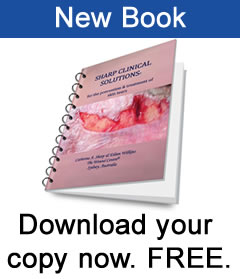Methicillin-resistant Staphylococcus aureus
There is a lot of talk around the world about introducing new categories to describe the degree of infection in chronic wounds e.g. ‘critical colonisation.’
I wonder if we should just get an understanding of the basics i.e. transmission of organisms and cross-infection and correct that first because it is a lack of understanding that kills patients!
A major culprit in cross-infection in all types of healthcare facilities is methicillin-resistant Staphylococcus aureus (MRSA). It is endemic in tertiary referral hospitals in the developed world. [1] The first Australian isolation was made at the Royal Prince Alfred Hospital (RPAH) in Sydney, Australia , in 1965. [2]
So what is MRSA and how can we stop the spread of this potentially deadly nosocomial (hospital acquired) pathogen that has become resistant to so many antibiotics? It is a problem particularly for susceptible patients: neonates, immune suppressed and those undergoing surgical procedures. It can cause infection in wounds, urinary tract, blood and lungs to name but a few sites in the body.
Staphylococcus aureus, which ordinarily lives in the nose and skin of humans, is a harmless berry-shaped (cocci) organism.
Staphylococcus aureus causes problems when it enters what is normally a sterile body site e.g. the bloodstream, urinary tract and wound tissue. If the host (the patient) cannot destroy the numbers of bacteria the result may be, for example, a bloodstream infection (bacteraemia), a urinary tract infection or a wound infection. A wound may exude frank pus as seen in this pressure ulcer.
In fact Staphylococcus aureus was discovered in pus from surgical abscesses in Scotland in 1880 by Sir Alexander Ogston, a surgeon but it was many decades before penicillin became available to treat patients.
PENICILLIN
When penicillin became available in the early 1940s the prognosis for patients with staphylococcal infection improved radically. Unfortunately within a couple of years the first penicillin-resistant staphylococci were recognized, first in hospitals and subsequently in the community. [3] Resistance to penicillin continued to grow, prompting scientists to develop methicillin, the first semi-synthetic penicillinase-resistant penicillin in 1961. Soon after its introduction however, there were reports of methicillin-resistant Staphylococcus aureus (MRSA). [4]
HOW IS MRSA SPREAD?
You are probably all aware that one of the main ways that cross infection occurs is poor hand hygiene. When healthcare workers move from one task or patient (e.g. bed-making) to another (e.g. changing a wound dressing) without hand-washing or hand-rubbing with an alcohol based solution*, pathogenic (disease causing) organisms such as MRSA can be spread andcan be deadly!
(* see hand hygiene, infection control and bed-making )
But when you think about it, unclean hands are only one mode of spread. Anything; bed-linen, clothing, sphygmomanometer cuffs, tourniquets, rolls of tape used to secure dressings — any object that can harbor pathogenic microorganisms (e.g. MRSA) can serve as an agent of transmission of infection.
Collectively these objects are known as ‘fomites’. Look at all the fomites that are used on patient after patient and NEVER CLEANED!!! —- tourniquets and sphygmomanometer cuffs…
Mary Beard demonstrated, in 1969, how new sphygmomanometer cuffs became highly contaminated with pathogenic micro-organisms soon after their introduction into wards at RPAH. [5] Still, they are never washed between patients. I have never known of any healthcare facility where routine practice is for patients to have their own clean sphygmomanometer cuffs (until they acquire MRSA- then they are isolated with their own equipment) …..Strange!!! Seems a bit back-to-front to me!!
‘When such a potential source of sepsis is unrecognized the risks of transmission become magnified as no steps are taken to minimize them.’ [5]
We give patients clean sheets and clean gowns. There would be an outcry if ever we used the same unwashed gown on two patients never mind hundreds or thousands of patients! Yet the same sphygmomanometer cuff is wrapped around arm after arm after arm… gathering more and more bugs.
And 40 years after Beard’s [5] research , testing again carried out at RPAH, showed MRSA to be present not just on sphygmomanometer cuffs and tourniquets, but on scissors, sink basins, taps, soap dispensers and the nurses station. [1] So even the most diligent healthcare worker who washes his or her hands has no hope of stopping cross-infection if they have to handle dirty equipment!
References
1. Barakate MS. Harris JP. West RH. Vickery AM. Sharp CA. Macleod C. Benn RA. A prospective survey of current methicillin-resistant Staphylococcus aureus control measures. Australian and New Zealand Journal of Surgery. 1999; 69(10):712-6, Oct.
2. Barakate MS. Yang YX. Foo SH. Vickery AM. Sharp CA. Fowler LD. Harris JP. West RH. Macleod C. Benn RA. An epidemiological survey of methicillin-resistant Staphylococcus aureus in a tertiary referral hospital. Journal of Hospital Infection. 2000; 44(1):19-26, Jan.
3. Rammelkamp CH, Maxon T. Resistance of Staphylococcus aureus to the action of penicillin. Proc. Royal Soc. Exper. Biol. Med. 1942;51:386–389.
4. Jevons MP. “Celbenin”-resistant staphylococci. Br. Med. J. 1961;1:124–125.
5. Sphygmomanometers as a reservoir of pathogenic bacteria. Beard MA. McIntyre A. Rountree PM. The Medical Journal of Australia 1969; 2: 758

